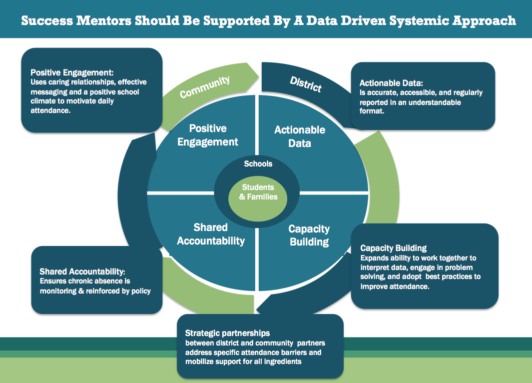What Support is Needed from the District?
Support from the district leadership for the success mentor strategy is essential to ensuring that this approach can go to scale and be sustained over time. A skilled success mentor captain who shepherds the work forward is critical. A district captain will be much more effective if her role is supported and embedded within a larger approach to district change that incorporates the key ingredients of systems success in this graphic, and described in the text below.
Accurate, easily accessible, up-to-date data that shows which and how many students are chronically absent — ideally broken down by school and grade — is essential. Data on which students are chronically absent is needed to match students with a success mentor, trigger a timely response if a student starts to miss school and monitor progress over time. Such student-level data should be available weekly if at all possible. Data on overall levels of chronic absenteeism — again broken down by school, grade and sub-population — might be examined less frequently, possibly at the end of each month or quarter to inform the development of school wide strategies. Chronic absence data should be produced by the district and then shared on an on-going basis with school personnel and with community partners.
Keep in mind that districts can share aggregate data on overall chronic absence rates for schools, grades and neighborhoods with their community partners and make it publicly available. If a community partner is working with an individual student, they can see that child’s information as long as the parent has given consent or if their organization has a data sharing agreement with the school district.
The US Department of Education has developed a toolkit to help manage student privacy when sharing data. The Data Sharing Toolkit for Communities: How To Leverage Community Relationships While Protecting Student Privacy, simplifies the complex concepts of federal privacy laws, and includes a collection of one-page resources.
Positive engagement occurs when a welcoming school environment, meaningful relationships and effective messaging help motivate students and their families to show up every day. An intentional shift from using the threat of fines or court action to compel attendance, this approach helps change behavior by debunking the myths that prevent families from recognizing the adverse consequences related to too many absences, especially among our youngest students. Find resources about positive engagement, such as handouts, videos, presentations and more on our website in the Resources Section under Messaging. The Attendance Works’ Bringing Attendance Home toolkit is a valuable resource for positive engagement with parents.
It is essential to build the skills and knowledge of school staff and community partners to understand what chronic absence is and use data to take a comprehensive, tiered approach to improving attendance. In districts implementing the national success mentor model, it involves paying special attention, hiring a strong coordinator and helping them implement the steps outlined in the elements outlined in section B of this toolkit: How Do We Get Started?
Shared accountability refers to when schools and their community partners see themselves as responsible for working together to monitor and address chronic absence. Although reporting on chronic absence is now built into the new education law Every Student Succeeds Act, districts have tremendous flexibility around how they will encourage schools to examine the extent to which chronic absence is a problem and describe how they will improve student attendance, especially among the most vulnerable populations, in school improvement plans. In a success mentor district, shared accountability also involves investing the time and staff to monitor chronic absence data over time, invite key partners to regularly review results of the strategy and jointly determine how to engage in continuous improvement.
While the work begins with the district and schools, strategic partnerships with community agencies – both public and private – are essential to creating a culture of attendance. Community partners can bring in invaluable expertise and resources that help to address barriers to getting to school such as chronic health issues and transportation challenges, as well as adults who can potentially serve as success mentors. Especially in schools with high levels of chronic absence, school staff alone are unlikely to have the capacity and resources to ensure that all chronically absent students have a success mentor. Consider reading the resources created by Baltimore City Public Schools to develop partnerships, found below.
